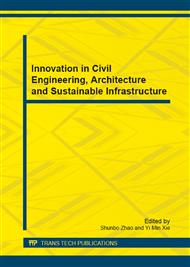p.3
p.9
p.13
p.17
p.22
p.26
p.33
p.37
A Study on Structure and Properties of Basalt Fiber
Abstract:
The structure and properties of a kind of domestic continuous basalt fiber is analyzed in the paper. Chemical composition, crystal structure, thermal properties, flammability, mechanical properties and morphology of the fiber are investigated. Element analysis experiment shows that the basalt fiber is a kind of aluminosilicate fiber which mainly composed of the oxides of such elements as Fe, Si, Ca, Al, K, Mo, Ti, Ba and so on. X-ray diffraction indicates that the bulk structure of the fiber is non-crystal with short range order. SEM observation finds that basalt fiber is circular in cross-section and smooth in longitudinal direction. Solubility experiment reveals the superior resistance of the fiber to acids, alkaline and organic solvents. DGA demonstrates there are three weight loss stages in the process of elevating temperature. There are, respectively, evaporation of moisture in the fiber at about 100°C, decomposition of the residual carbonate minerals between 480°C and 630°C, and decomposition of newly generated carbonates between 850°C~995°C. In heatflow curve, there are also three endothermic peaks in which the first and the second correspond to the last two stages of weight loss and the third corresponds to melting process of the fiber and it onsets from 1122.14°C, comes to its peak value at 1194.96°C and ends at 1380°C. The tensile strength of the basalt fiber is better than S-glass fiber, worse than carbon fiber. Flammability of the fiber is also analyzed.
Info:
Periodical:
Pages:
17-21
Citation:
Online since:
November 2012
Authors:
Keywords:
Price:
Сopyright:
© 2012 Trans Tech Publications Ltd. All Rights Reserved
Share:
Citation:


